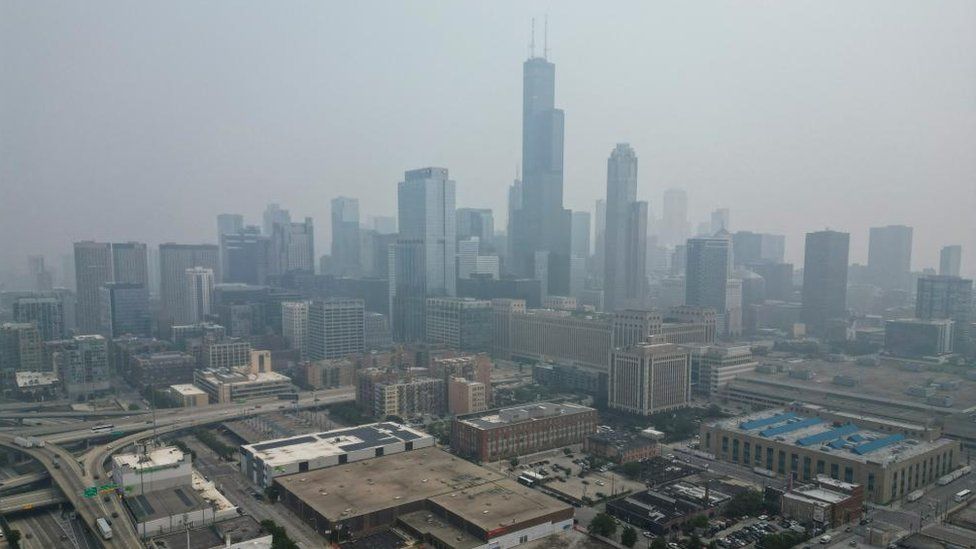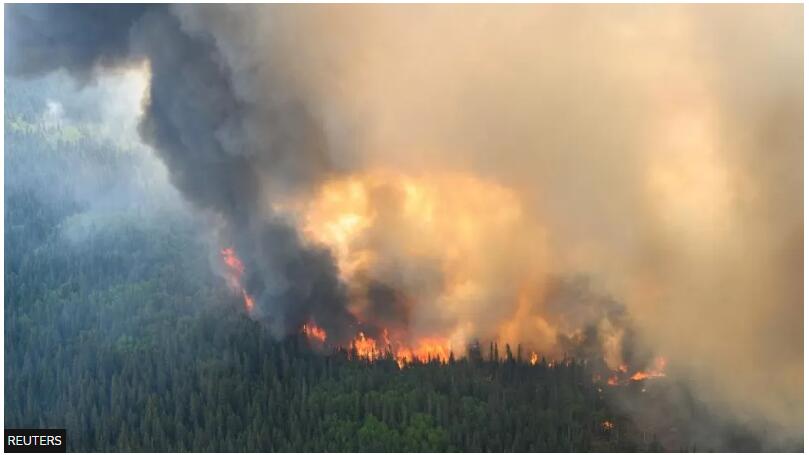Canada wildfire season is now the worst on record
Canada has surpassed its record for the largest area burned by wildfires in a single year.
The blazes have burned more than 8.1m hectares (20m acres) across the country – 21 times above the average over the last decade.
There are currently 483 wildfires across Canada. More than 250 of those are considered to be out of control.
The wildfires have also produced record levels of carbon emissions, with smoke reaching as far as Europe.
The previous Canadian record for area burned by wildfires was set in 1989 from more than 11,000 blazes, according to government figures.
While this year’s fires are smaller in number – nearly 3,000 so far in 2023 – they are much larger in size.
Federal officials in Canada said the fires have been more widespread “than in recent memory”.
In Toronto and Ottawa, the air quality is projected to be a “high risk” to people’s health on Wednesday and into Thursday. In Windsor on the US-Canada border, the air quality is classified as “very high risk”.

In some parts of Quebec, where 115 fires were burning as of Wednesday, some firefighting helicopters and water bombers were unable to take off this week due to the dense wildfire smoke, the province’s firefighting agency said.
The fires have been felt far beyond Canada’s borders, with tens of millions of people across a swathe of the US from Kansas to Kentucky under air quality alerts on Wednesday.
In the US, air quality in parts of Illinois on Wednesday was classified as “very unhealthy”, and the smoke forced Chicago schools to hold summer programmes indoors.
Chicago, along with Detroit and Minneapolis, ranked as having one of the worst air quality levels in the world, and cities on the east coast are bracing for smoky conditions to worsen on Thursday.
The European Union’s Copernicus Atmosphere Monitoring Service (CAMS) said the smoke has travelled far east over the Atlantic Ocean to Ireland, France and Spain.
CAMS also said the wildfires have released 160 million tonnes of carbon, the most of any year since 2014.
Officials have said the number of wildfires Canada has seen so far this year is “unprecedented” for this early in the wildfire season, which typically lasts from May to September.
Experts have pointed to a warmer and drier spring than normal as the reason.
These conditions are projected to continue throughout the summer, fuelling a high risk of wildfires from the west coast province of British Columbia to Atlantic Canada in the east.
“Climate change is increasing the frequency and intensity of wildland fires and creating longer fire seasons in Canada,” said Michael Norton, director general of the Northern Forestry Centre at Canada’s Department of Natural Resources.
Wildfires have temporarily evacuated more than 120,000 people across the country to date.
Some fires have destroyed homes and properties. A wildfire near Halifax – the largest city in Nova Scotia – destroyed more than 200 structures in May.
Fires in western Canada began at the start of May and continue to burn. British Columbia is still battling its largest wildfire on record – Donnie Creek – burning at more than 550,000 hectares.
Along with local firefighters, Canada has deployed its military across the country to help battle the wildfires.
Nearly 1,500 firefighters from other countries, including the US, Australia, New Zealand and South Africa, France, Mexico, Spain and Chile, were on the ground.
Canada last week signed an agreement with the US on wildfires, which makes it easier for the two countries to help each other as they battle the respective blazes.
Prime Minister Justin Trudeau has described the wildfire situation in the country as “difficult and heart-breaking”.
A number of burn bans are in place across the country and officials have warned Canadians to take extra care in areas deemed at a high risk of wildfires.
